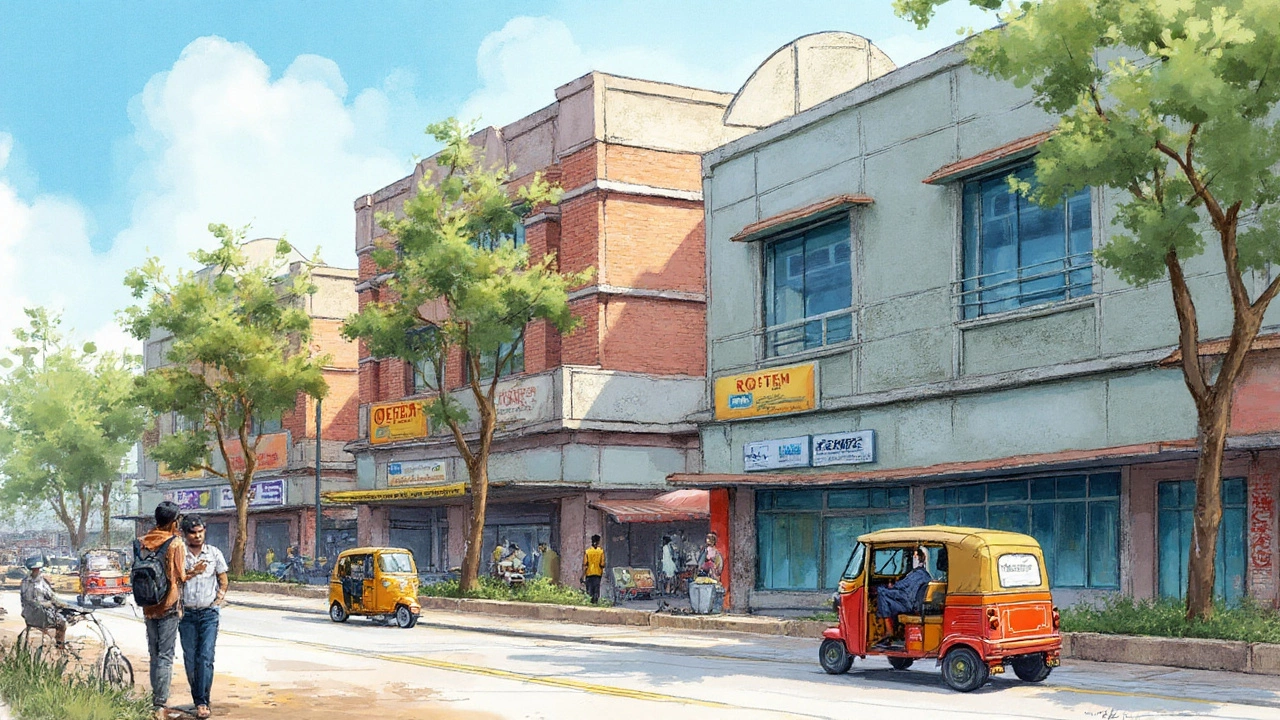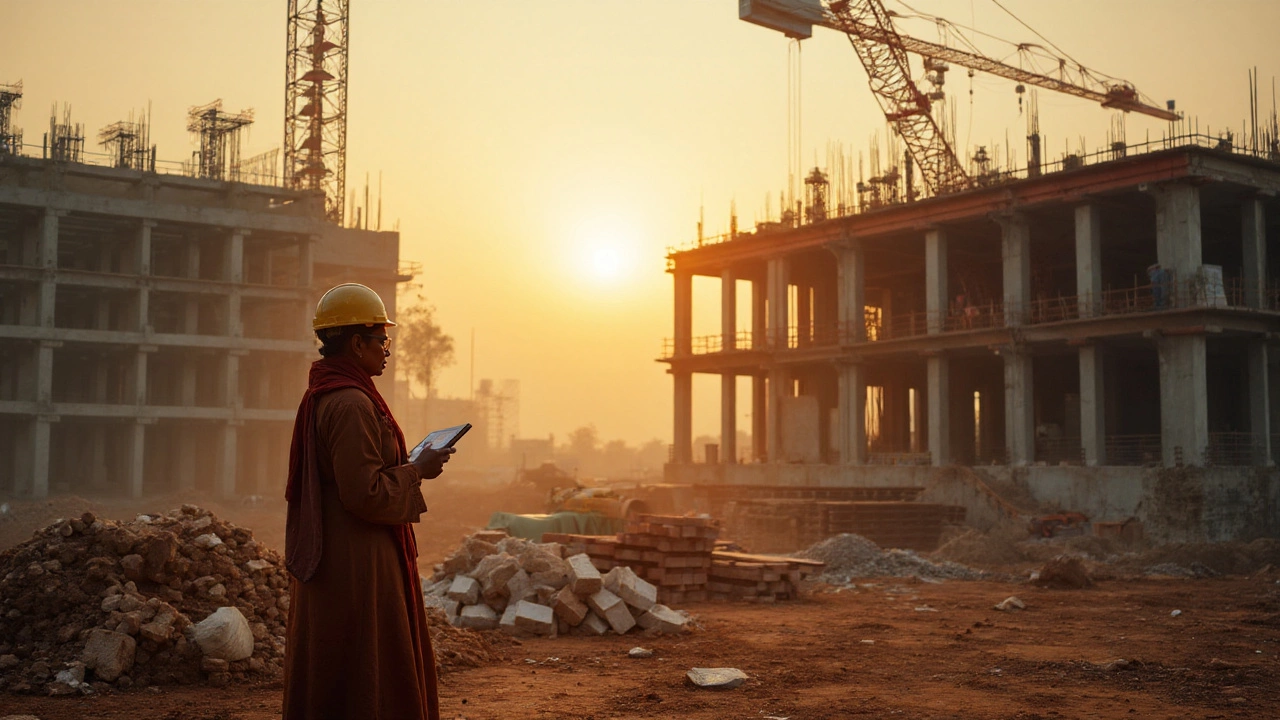People expect a one-line answer here, but there are two honest ways to answer this question. “Most” commercial buildings can mean by count or by floor area-and you can sort them by code classification or by the material system that actually holds the building up. If you want the right mental picture fast, you need both views.
TL;DR
- By code, most modern mid- to large commercial buildings are Type I or Type II (noncombustible) under the International Building Code (IBC). Small low-rise storefronts and offices are often Type V-B (wood) or Type III.
- By structure, the workhorses are tilt-up concrete walls with steel roofs for big-box/warehouse, structural steel frames with composite decks for offices, reinforced concrete for parking and high-load floors, and pre-engineered metal buildings for budget warehouses.
- By count, the majority of everyday low-rise commercial shells (strip retail, small offices, flex) lean toward Type II-B tilt-up/pre-engineered or Type V-B wood. By total square footage, noncombustible steel and concrete dominate.
- Pick based on height/area limits, spans, schedule, local labor market, and occupancy. Mass timber is rising for 5-8 story offices and schools in some markets.
- Primary sources: International Building Code 2024 (IBC Types I-V), NFPA 220 (construction types), AISC Steel Construction Manual, ACI 318 (concrete), RSMeans 2024-2025 (cost data), U.S. EIA CBECS (building stock context).
How commercial buildings are classified (and why “most” depends on your lens)
When someone asks, “What type of construction are most commercial buildings?” they usually mean one of two things:
- Code classification (IBC Types I-V): how the code treats the building in terms of combustibility and fire-resistance ratings.
- Structural system/material: the actual frame and skin-steel, reinforced concrete, tilt-up concrete, masonry, wood, or hybrids.
Here’s the quick decode, starting with the code side. The IBC (2024) groups construction into five buckets (NFPA 220 aligns with this too):
- Type I: Noncombustible, highest fire-resistance. I-A is the most robust. Think high-rises, hospitals, airports.
- Type II: Noncombustible, but lighter fire-resistance. II-A has rated elements; II-B often unrated. Think big-box retail, typical warehouses, many single-story schools and offices.
- Type III: Noncombustible exterior walls, combustible (often wood) interior framing. Common in older main-street buildings and some new mid-rise over podium in certain jurisdictions.
- Type IV: Mass timber (heavy timber/CLT/GLT). Newer IBC editions expand it (IV-A/B/C) with height/area allowances. Used for mid-rise offices and schools where code and markets support it.
- Type V: Combustible (wood) throughout. V-B is the least restrictive. Think small offices, shops, restaurants, and many suburban infill projects.
Now the practical view-the stuff you see on site plans and submittals:
- Tilt-up concrete: Site-cast wall panels lifted into place, paired with steel bar joists or open-web steel trusses for the roof. King of distribution centers and big-box retail shells.
- Structural steel frame: Columns, beams, and composite metal deck. Common for mid-rise offices, medical offices, and urban infill where speed and long spans matter.
- Reinforced concrete: Cast-in-place or post-tensioned slabs/frames. Great for heavy floor loads (labs, parking), vibration control, and high fire ratings.
- Pre-engineered metal buildings (PEMB): Factory-designed steel frames with metal wall/roof panels. Very cost-efficient for warehouses, self-storage, and service centers.
- CMU (concrete masonry unit) + steel roof: Public schools, gyms, civic buildings-durable walls, steel roof framing.
- Wood/light-frame and mass timber: Small retail/office (light-frame), or signature mid-rise projects using CLT/GLT where code and market favor it.
So what’s “most”? Two honest ways to say it:
- By floor area built since the 1990s, warehouses and big-box retail have dominated in many U.S. metros. That skews “most” toward Type II-B noncombustible shells-often tilt-up with steel roofs or PEMBs. Ask any industrial broker.
- By raw building count, strip retail bays, small offices/clinics, restaurants, and suburban service buildings are everywhere-many are Type V-B (wood) or II-B depending on local code, sprinkler strategy, and exterior walls.
What about cities with skylines? Urban commercial cores push the pie toward Type I steel/concrete frames-especially anything tall or with tight site logistics. Hospitals, airports, and long-span venues also pack a lot of square footage and land in Type I.
Here’s a simple rule-of-thumb that matches the IBC and typical market behavior:
- 1-2 stories, under ~100,000 sq ft: Often Type II-B tilt-up or PEMB; sometimes Type V-B wood (office/retail) or CMU+steel in public/institutional work.
- 3-6 stories, urban: Steel or reinforced concrete, Type I-B or II-A/II-B, depending on height/area and occupancy. Podium options shift this.
- High-rise or essential facilities: Type I-A/I-B steel or concrete.
On the “source of truth” front, the IBC 2024 defines the construction types and fire-rating requirements; NFPA 220 provides aligned classifications. For cost and schedule deltas, estimators lean on RSMeans 2024-2025 and vendor quotes. For macro stock trends, the U.S. EIA’s Commercial Buildings Energy Consumption Survey (CBECS) helps show how much floor area sits in retail, office, and warehouse-useful context for why tilt-up and steel systems keep winning market share.
Bottom line: if you picture a typical U.S. commercial building, you’re usually looking at noncombustible Type II-B tilt-up or PEMB for wide, low boxes; steel or concrete for urban mid-rise; and a steady base of Type V-B wood for small neighborhood retail and offices.
Because this question often shows up in code research and early design, a shared vocabulary helps. When someone says commercial building construction types, ask whether they mean IBC (Types I-V) or the structural system (steel, concrete, tilt-up, etc.). You’ll save hours of confusion.

How to choose the right construction type for your project (a simple decision path)
Here’s a fast, practical way to decide what fits your job. Work through these five steps, in order. Don’t start with “what’s cheapest” until you confirm code limits-sometimes cheap isn’t legal or won’t get you the area you need.
Lock height/area and occupancy per IBC. The IBC sets maximum height and area by construction type and occupancy. You don’t need to memorize tables-just know the hierarchy: Type I allows the largest envelopes, Type V the smallest. Sprinklers and frontage can buy you area. Your code consultant or architect will run the exact numbers.
Choose span strategy and floor performance. Long, open bays? Steel with composite deck (typical 30-45 ft bays) or precast/prestressed options. Heavy loads or low vibration (labs, hospitals)? Reinforced or post-tensioned concrete shines. Very wide, single-story roofs with few columns? Steel bar joists or tapered PEMB frames carry those spans economically.
Match system to schedule and labor market. Steel frames fly once the fabrication lands. Tilt-up screams speed where panels can be cast onsite and crane access is clean. Concrete takes time but can be the best move when formwork crews are strong and rebar supply is stable. Labor availability in your market matters more than people admit.
Check enclosure, energy, and lifecycle needs. Insulated sandwich tilt-up panels can meet energy codes cleanly. PEMBs today come with tested insulated metal panels (IMPs). Urban glass boxes over steel need careful envelope detailing to hit local energy standards. Think about maintenance, corrosion, and durability in your climate.
Pressure-test budget with order-of-magnitude costs. Ranges move with markets, but here’s a 2025 sanity check from recent RSMeans data and live bid climates in many U.S. metros (soft costs excluded):
- Tilt-up + steel roof (warehouse/big-box shell): roughly $90-$150/sf, driven by slab thickness and dock equipment.
- Pre-engineered metal building: roughly $70-$130/sf for basic shells; interiors and MEP drive the real number.
- Structural steel mid-rise office: roughly $200-$350/sf for core/shell; Class A urban cores can push higher with finishes and systems.
- Cast-in-place/post-tensioned concrete: roughly $220-$380/sf for office/parking-intensive programs; heavy labs exceed this.
- Mass timber mid-rise: often competitive with steel/concrete on total project cost when schedule savings count; material premiums vary by region and supply.
Always cross-check with a local GC/estimator. Commodity swings, union vs. open shop, and site logistics can shift costs 20% either way.
If you want a quick tie-back to code:
- Warehouse/big-box: Type II-B (unrated noncombustible) is common with tilt-up or PEMB, often fully sprinklered.
- Mid-rise office/medical: Type I-B or II-A with steel or concrete frames.
- Schools/civic: Often Type II or III with CMU + steel roofs; some go mass timber where policy encourages it.
- Small retail/office: Type V-B wood where allowed; Type II-B or III where noncombustible exteriors or urban fire separations are required.
Special-use exceptions (Group H hazardous, essential facilities, high-rise fire command center rules, podium structures) can change the calculus. That’s when you bring your code consultant in early.
What the “usual suspects” look like in the wild (and how to spot them fast)
Let’s make this concrete with real-world profiles. I’m giving you a fast way to ID a building type from the curb or during a walkthrough.
Distribution center, 400,000 sq ft, 36-40 ft clear, in a logistics park
- Likely system: Tilt-up concrete wall panels + steel bar joists/open web joists + TPO roof.
- Code type: Type II-B, fully sprinklered (ESFR or CMDA depending on racking).
- Tell-tales: Vertical panel joints at 20-30 ft, steel rod braces during erection, wide column spacing (50-60 ft), dock pits lined up on the long side.
Big-box retail, 55,000 sq ft, suburban arterial
- Likely system: Tilt-up walls or CMU with steel joists; shallow steel moment frames at entries.
- Code type: Type II-B, sprinklered; big open sales floor.
- Tell-tales: Panel daylights, parapets at facade branding, bar joist webbing visible in back-of-house.
Five-story office over retail, urban infill
- Likely system: Structural steel frame with composite slabs, or post-tensioned concrete.
- Code type: Type I-B or II-A depending on height/area.
- Tell-tales: Spray-applied fireproofing on steel in the garage or mechanical rooms; metal deck visible before concrete pour.
Community school, two stories, gym + classrooms
- Likely system: CMU load-bearing or hybrid CMU/steel, steel roof trusses over the gym.
- Code type: Type II or III, often with rated corridors and compartmentation.
- Tell-tales: Exposed CMU in service areas, brick veneer over CMU at facade, tall roof structure over gym volume.
Small dental office or cafe pad, single story
- Likely system: Wood framing with stucco or fiber-cement cladding; or light-gauge steel studs and metal trusses.
- Code type: Type V-B (wood) or II-B if noncombustible envelope is required.
- Tell-tales: Wood truss plates visible in attic access, stud spacing at 16 or 24 in, light roof loads.
Boutique office, 6 stories, green branding
- Likely system: Mass timber (CLT floors, glulam columns/beams) over concrete podium.
- Code type: Type IV-B/IV-C under IBC 2024 where adopted.
- Tell-tales: Exposed timber ceilings, concealed MEP in dropped bands, fire protection strategy integrated with timber layers and charring allowances.
If you’re walking a shell and want to hazard a guess in 30 seconds, use this triage:
- Look at exterior walls: continuous tilt-up panel seams (tilt-up), horizontal ribs and metal panels (PEMB), brick/CMU bond lines (masonry), glass/curtain wall with steel inside (steel frame).
- Peek above the ceiling: open-web steel joists (steel roof), wood trusses (wood), concrete slab soffits with drop panels (concrete).
- Find fireproofing: thick spray-applied fireproofing = steel frame; concrete often shows rebar ties or PT anchor points; mass timber shows timber with visible connectors.
That gets you right 80% of the time.

Cheat sheets, comparisons, and quick answers (FAQ included)
Use these to make fast calls or prep for a chat with your architect/GC.
Fast match by goal:
- Fastest shell delivery on a clean site: Tilt-up or PEMB.
- Longest open spans in one story: PEMB or steel joists with tilt-up walls.
- Best for heavy floors/labs/parking: Reinforced or post-tensioned concrete.
- Eye-catching warmth with a low-carbon story: Mass timber.
- Tight urban site with schedule pressure: Structural steel frame.
Common traps to avoid:
- Assuming Type V-B is allowed everywhere. Urban sites, zero-lot-line conditions, and mixed occupancies can block it.
- Forgetting sprinklers change area/height allowances. Sprinklers can be worth it even if not required, purely for the area bump.
- Underestimating roof snow/wind drift in PEMBs. The frame price looks great until you add purlin and bracing changes for climate loads.
- Ignoring slab design for racking or equipment. Upgrading slab thickness and reinforcing later costs far more than doing it up front.
- Not planning panel embed locations in tilt-up. Late changes mean field welding or core drilling through rebar-never fun.
Quick comparison highlights (what you trade):
- Tilt-up vs. PEMB: Tilt-up gives a robust exterior, good energy performance with insulated panels, and easy opening changes. PEMB beats on initial cost and speed for simple boxes.
- Steel vs. Concrete mid-rise: Steel wins schedule and lighter foundations; concrete wins on vibration control and inherent fire resistance. Market crews decide cost in your city.
- Mass Timber vs. Steel/Concrete: Timber shines in biophilic design and speed when supply is local; requires careful detailing for acoustics, MEP routing, and fire strategy.
FAQ
What IBC type is a typical warehouse? Usually Type II-B noncombustible, fully sprinklered, with tilt-up concrete walls and steel roof framing.
Are most commercial buildings steel or concrete? For mid- and high-rise, yes-steel or reinforced concrete dominate. For single-story boxes, tilt-up + steel or PEMBs are more common.
Is wood common in commercial? In small offices/retail (Type V-B) and in newer mass timber mid-rise where code allows it. It’s very common in suburban pads and main-street infill.
What are the A vs. B suffixes in the IBC types? “A” generally indicates more fire-resistance rating than “B.” Type II-A has rated elements; II-B often does not. Your allowed height/area shifts with that rating and with sprinklers.
Where do podium buildings fit? Podiums use IBC separation to treat upper stories as a different construction type/occupancy-common for mixed-use. The podium itself is typically Type I.
What primary sources back this? IBC 2024 defines Types I-V; NFPA 220 aligns on construction types; AISC Steel Construction Manual and ACI 318 govern steel and concrete design; RSMeans 2024-2025 guides costs; EIA CBECS provides stock context.
Next steps based on your scenario:
- Developer chasing a warehouse in a growth corridor: Start with a Type II-B tilt-up or PEMB baseline. Confirm sprinkler strategy (ESFR vs. CMDA), slab loading (future racking), and dock counts. Price alternates early for roof insulation and skylights.
- Owner-occupier planning a 4-6 story office: Run steel vs. post-tensioned concrete in parallel schematic pricing. Compare vibration criteria, bay layout, and facade impacts on energy code. Don’t forget MEP shaft planning.
- School district evaluating a new middle school: Shortlist CMU + steel roof and mass timber. Run lifecycle costs and acoustics. Check local adoption of IBC 2024 mass timber provisions.
- Retailer building a pad site: Ask if Type V-B wood is allowed on your parcel. If not, look at light-gauge steel framing with noncombustible cladding to stay in Type II-B.
Troubleshooting quick hits:
- Height/area won’t fit your desired footprint: Consider sprinklers, frontage increases, or a podium approach to “reset” construction type above.
- Steel lead times are blowing up: Price a concrete frame or a PEMB (for single-story) with earlier release of the metal building package.
- Envelope not meeting energy targets: Move to insulated sandwich tilt-up, IMPs on PEMB, or add continuous insulation. Model 3-4 options; the cheapest wall sometimes costs more to heat and cool.
- Vibration sensitive tenants (dentists, labs): Concrete slabs or damped steel systems; confirm criteria in early design.
If you keep one mental model from this piece, make it this: code type sets your legal box, structural system sets your speed and spans, and local market sets your real cost. Get those three in line, and the “most common” answer takes care of itself on your project.
